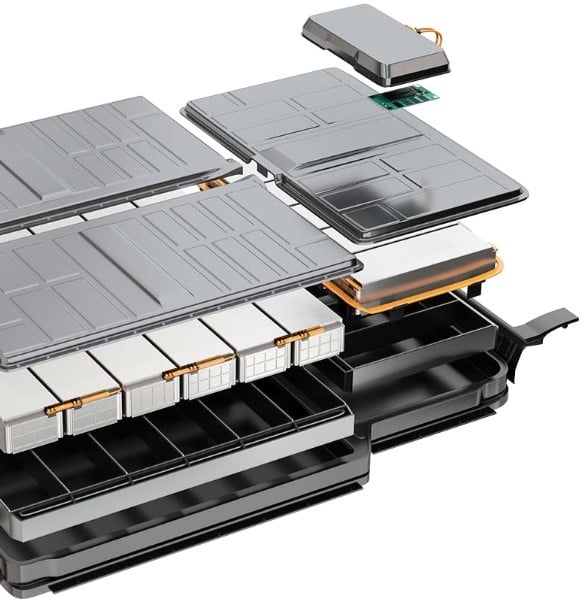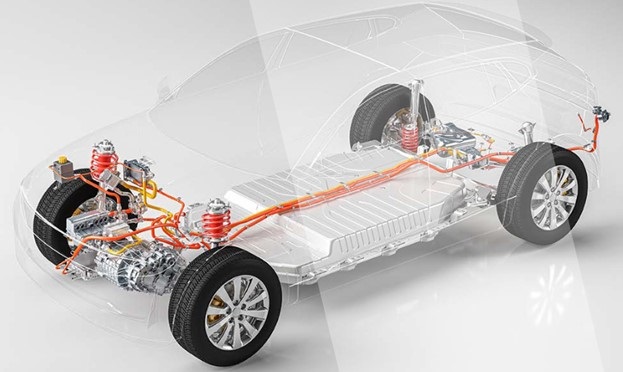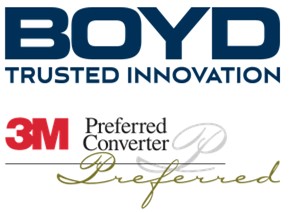 Figure 1: From electric scooters to utility vehicles, recreational vehicles and more, production of EVs is growing across the board. Source: Boyd
Figure 1: From electric scooters to utility vehicles, recreational vehicles and more, production of EVs is growing across the board. Source: Boyd
Demand for electric vehicles (EV) has increased dramatically in recent years, and many OEMs are scrambling to meet production needs. It’s not just in automotive either. From electric scooters to utility vehicles, recreational vehicles and more, production of EVs is growing across the board.
To build the next generation of EVs, engineers are striving to increase power density and make batteries smaller and lighter to improve range and efficiency, and provide more design freedom. But with increased power comes an increased risk of thermal runaway events and fire. So, OEMs need to develop effective thermal runaway protection (TRP) solutions to satisfy growing market demand while ensuring user safety.
There is currently a lack of clear regulation around TRP standards. But across the industry, many OEMs have adopted the “5-minute rule” as the standard, meaning if a thermal runaway event happens, passengers have five minutes to exit the vehicle before it becomes fully engulfed.
Regulatory requirements are expected to evolve with changing battery technology, but OEMs and battery suppliers need technology partners with TRP expertise to help design and manufacture reliable, safe TRP solutions that meet the needs of today and into the future.
Boyd creates robust TRP solutions for multiple battery types, including pouch cell, cylindrical cell and prismatic cell batteries. Boyd’s TRP expertise extends to battery modules and full battery packs, creating reliable solutions for every type and level of EV battery design. This whitepaper explores the different thermal runaway solution types that Boyd offers, and the materials and converting services used to optimize these products for EV battery applications.
Battery cell solutions
There are three main types of EV battery cells: pouch cells, cylindrical cells and prismatic cells. Each has its own unique advantages and disadvantages, as well as manufacturing and design considerations. TRP must be tailored to fit these designs.
 Figure 2: Pouch cells are made using flexible materials. Source: Boyd
Figure 2: Pouch cells are made using flexible materials. Source: Boyd
Pouch cells
Pouch cells are made using flexible materials and do not have a rigid structure. Instead, they typically use foil materials to create a pouch that contains the cell. This reduces the overall weight of the battery and provides more design freedom.
Compression pads — Compression pads are important for pouch cell batteries because cells tend to swell and compress as battery temperature cycles. Compression pads fit between cells to apply a consistent amount of pressure on the cells as they swell and compress. This is important because without constant pressure, batteries can develop what’s known as “vampire drain” where the battery slowly loses power during periods of inactivity, negatively impacting battery efficiency. Compression pads also aid in TRP by helping to block or isolate thermal runaway, reducing heat-generating friction, and protecting cells against impact, which can damage them and cause spark or shorting issues.
Flame barrier materials — TRP solutions are rarely a single component or material. Often, raw material combinations are used to leverage the best characteristics from each material, optimize performance, and achieve required compression set and force deflection. Boyd is an expert in specifying flame barrier materials like mica and ceramic fibers with complementary high-performance materials to create multilayered stackups. 3M Flame Barrier Paper FRB is another high-temperature material used in a variety of EV battery applications. Its densified material provides higher dielectric strength, a smoother surface for improved tape adhesion and a closed cell structure. Aerogels can also play a critical role in TRP solutions.
 Figure 3: Boyd experts work closely with OEMs to understand vehicle and battery requirements. Source: Boyd
Figure 3: Boyd experts work closely with OEMs to understand vehicle and battery requirements. Source: Boyd
How these materials come together depends on the specific application. For example, Boyd engineers could simply sandwich an aerogel between two layers of pressure-sensitive adhesives
to create an effective thermal barrier. In other instances, Boyd may add double-sided tape to either side of an aerogel, and then add a layer of ceramic or compression paper to the top and bottom layer to create a more robust stackup. Solutions must be customized and optimized to meet precise application specifications to be the most reliable, safe and effective. Boyd experts work closely with OEMs to understand vehicle and battery requirements. They then recommend and custom configure optimal materials to create custom, high-performance TRP solutions.
Cylindrical cells
Cylindrical cells are made from anodes, separators and cathodes that are stacked together and rolled up before they are placed in a cylinder-shaped container. A single AA battery is a good example of this type of structure.
Cell-to-cell bonding solutions — Boyd offers a wide range of pressure-sensitive adhesives from 3M that require no cure time to bond cells to one another, thereby enhancing the structural integrity of EV battery pack assemblies. Flame-retardant and dielectric tapes bond with immediate strength and are easier to work with than liquid adhesives in manufacturing environments. Boyd specifies and fabricates these and other adhesives into custom solutions optimized for battery packs with tight tolerance and cleanliness controls to prevent contamination and achieve the precision required to effectively assemble TRP solutions into battery modules and packs.
Flame barrier materials — Just like with pouch cells, Boyd specifies and custom configures flame barrier and thermal insulation materials to wrap cells and prevent spark voltage between internal critical components that can lead to device shorting or fire. They also engineer and specify thermal interface materials to enhance TRP solutions, including gap fillers, thermal putties, thermal interface sheets, phase change materials and thermally conductive insulators.
Prismatic cells
Prismatic cells are similar to cylindrical cells in that they are made from sheets of anodes, cathodes and separators all sandwiched together. Instead of being rolled into a cylinder, these materials are either stacked in layers or rolled and then pressed to fit into rigid housing, typically made from either plastic or metal.
OEMs leverage Boyd’s expertise and capabilities to create high-performance TRP solutions for batteries with prismatic cells. Many of the same types of compression pads and flame barrier materials used with other battery cell types are specified with prismatic cells to add TRP.
Battery module solutions
Battery modules are the next “level” of battery constructions and are created when multiple cells are packaged together. This is true for all types of battery cells.
Compression pads — Similar to the cell level, compression pads insulate individual battery modules. Compression pad technologies are added to the outside or inside of the module to stop thermal runaway from propagating to another module, reduce friction between modules, and protect against mechanical energy from shock and vibration. This is important to prevent and contain thermal events, ensuring an issue local to one module doesn’t compromise the entire battery.
Seals and gaskets — Proper seals and gasketing are important for effective ingress protection, impact resistance and thermal management in EV battery assemblies. Boyd specializes in specifying optimal materials, like pressure-sensitive adhesives (PSAs) and high-performance foams, to produce battery module gaskets and port seals. To adhere environmental seals and gaskets to battery modules or ports and for internal component-to-component bonding, Boyd custom fabricates PSAs like VHB tape, adhesive transfer tape and other double-sided PSA tapes. These flexible adhesives save space, are more efficient to assemble, and are easier to work with than liquid adhesives. Custom gaskets and seals feature a variety of elastomer and polymeric materials with different durometers to match application requirement needs for compressibility, compression set resistance and waterproofing. Boyd’s rapid prototyping services accelerate testing and concept validation.
Liquid cold plates — Liquid cold plates facilitate thermal management of battery modules by transferring heat from the battery to the coolant fluid used within a liquid cooling system. Liquid cold plates work in tandem with engineered materials to provide effective, multilayered TRP in EV batteries. For example, Boyd laminates polyester dielectric tape onto the top of a cold plate with a release liner for easy assembly. The tape is an alternative to powder coating and provides an added layer of electrical insulation so product developers don’t have to worry about arcing, shorting or spark voltage that could start a fire.
Battery pack solutions
Multiple battery modules are assembled together to create a battery pack. This is the highest “level” of battery constructions.
Electrical insulators — Boyd specifies and custom fabricates a wide range of electrically insulating materials with thermally conductive tapes to protect battery packs from spark voltage, create flame barriers to isolate fire and prevent battery packs from overheating. Each OEM and battery pack uses a different kind of electrical insulator with adhesive system based on individual design and performance needs. Most electrical insulators are thin film polymer based, featuring polycarbonate, polypropylene or polyimide raw materials. Epoxy-based adhesives, various polyurethane adhesives, acrylic foam tapes and structural tapes are laminated to electrically insulating films to aid in the assembly process, adhere the insulators to the battery packs, and create a thermally conductive path through or around the electrical insulator.
Compression pads — In addition to being used at the cell and module levels, compression pads also protect battery packs. The same types of foams and other materials are added to the structure of the battery pack to provide enhanced impact and TRP. These components reduce the negative impact of friction, mechanical movement and swelling forces.
Seals and gaskets — Sealing EV battery enclosures or housing is critical to protect battery packs, modules and cells against liquid, gas and particulate intrusion. Specialty materials and smart gasket design waterproof and seal EV battery housings to protect sensitive battery components from contamination and road debris. They also help eliminate noise, vibration and harshness (NVH) challenges to optimize reliability, performance and the driver experience. Boyd engineers ensure all gasket and seal materials and their performance-matched adhesives are durable enough to withstand cycling temperatures within the battery environment and tough road and weather conditions around the battery housing without compromising performance. Boyd’s EV battery housing seals are designed to simplify customer assembly, design for manufacturing (DFM) throughput, material optimization, and are ruggedized to withstand harsh road conditions. This ensures the battery pack maintains an optimal operating environment to prevent thermal runaway over the life of the vehicle.
Liquid cold plates — Similar to their solution for the module level, Boyd develops liquid cold plate solutions optimal for EV battery packs. Cold plates can be laminated with dielectrically insulating tapes to provide electrical protection and strong bonds with other assembled components. Liquid cold plate designs that unlock maximum thermal performance create the most thermally efficient transfer of heat from the battery pack to the vehicle’s liquid cooling system. Meaning OEMs can design faster charge cycles, more powerful batteries, and extend charge range for vehicle owners while decreasing risk of thermal runaway and enhancing EV battery pack safety.
Working with eMobility experts
EV battery safety and performance are key to differentiate an EV and gain market share among a growing network of competitors. Thermal runaway is an important key in safe EV battery design. OEMs and EV designers approach solving thermal runaway problems in different ways. Some use mechanical-type TRP products that are bolted into the battery, others place TRP materials under the battery pack housing lid, while others engineer TRP solutions between battery cells or modules. There is no industry standard, one-size-fits-all approach to smart TRP design. But Boyd has solved TRP challenges in a multitude of diverse battery designs and approaches, meaning they are invested in TRP research and development with field-tested technologies that customers can leverage to optimize TRP solutions for their unique approach to battery design.
Boyd is the trusted global innovator of sustainable solutions that make their customers’ products better, safer, faster and more reliable. Boyd’s innovative engineered materials and thermal solutions advance their customers’ technology to maximize performance in 5G infrastructure and the world’s most advanced data centers; enhance reliability and extend range for electric and autonomous vehicles; advance the accuracy of cutting-edge personal healthcare and diagnostic systems; enable performance-critical aircraft and defense technologies; and accelerate innovation in next-generation electronics and human-machine interface. Core to Boyd’s global manufacturing is a deep commitment to protect the environment with sustainable, scalable, lean, strategically located regional operations that reduce waste and minimize carbon footprint. Boyd empowers their employees, develop their potential and inspire them to do the right things with integrity and accountability to champion their customers’ success.
As industry standards, production needs and customer demands change, improve battery performance, safety, efficiency and reliability with smart TRP solutions that are optimized for customers and theirapplication needs. Leverage a trusted partner with innovation road mapped to evolve to meet new requirements and manufacturing capacity to scale with customers as they ramp new model introduction. Boyd is a trusted advisor to eMobility OEMs and Tier 1 suppliers, helping some of the top brands in the industry improve battery design and prevent or protect against thermal runaway. Boyd’s technologies are installed in over 2 million eMobility vehicles and they have more than 60 years of field-proven experience in the automotive industry. Boyd means trusted innovation.
Boyd’s innovative problem solving, vast materials expertise, rapid prototyping and scalable manufacturing replicated in the global regions where their customers operate accelerate time to market and new model introduction. Cleanroom manufacturing and ISO 16949 automotive quality management system certified facilities around the world improve product quality, reliability, safety and repeatability. Boyd is also a global 3M Preferred Converter, meaning they have first access to leading material innovation.
 Boyd is the trusted global innovator of sustainable solutions that make their customers’ products better, safer, faster and more reliable. Their innovative engineered materials and thermal solutions advance their customers’ technology to maximize performance in 5G infrastructure and the world’s most advanced data centers; enhance reliability and extend range for electric and autonomous vehicles; advance the accuracy of cutting-edge personal healthcare and diagnostic systems; enable performance-critical aircraft and defense technologies; and accelerate innovation in next-generation electronics and human-machine interface. Core to Boyd’s global manufacturing is a deep commitment to protect the environment with sustainable, scalable, lean, strategically located regional operations that reduce waste and minimize carbon footprint. Boyd empowers their employees, develop their potential and inspire them to do the right things with integrity and accountability to champion their customers’ success.
Boyd is the trusted global innovator of sustainable solutions that make their customers’ products better, safer, faster and more reliable. Their innovative engineered materials and thermal solutions advance their customers’ technology to maximize performance in 5G infrastructure and the world’s most advanced data centers; enhance reliability and extend range for electric and autonomous vehicles; advance the accuracy of cutting-edge personal healthcare and diagnostic systems; enable performance-critical aircraft and defense technologies; and accelerate innovation in next-generation electronics and human-machine interface. Core to Boyd’s global manufacturing is a deep commitment to protect the environment with sustainable, scalable, lean, strategically located regional operations that reduce waste and minimize carbon footprint. Boyd empowers their employees, develop their potential and inspire them to do the right things with integrity and accountability to champion their customers’ success.
Ready to start a new project?
Contact Boyd today to see how they can help improve TRP in EV batteries.
